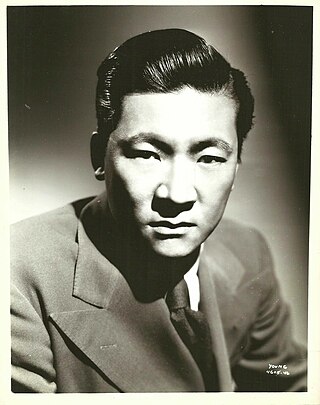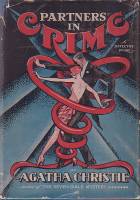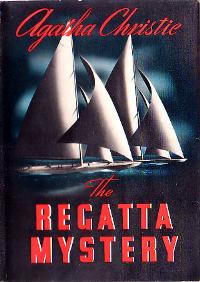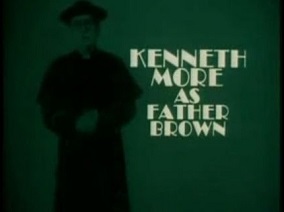
Gilbert Keith Chesterton was an English author, philosopher, Christian apologist, and literary and art critic.

The A.B.C. Murders is a work of detective fiction by British writer Agatha Christie, featuring her characters Hercule Poirot, Arthur Hastings and Chief Inspector Japp, as they contend with a series of killings by a mysterious murderer known only as "A.B.C.". The book was first published in the UK by the Collins Crime Club on 6 January 1936, sold for seven shillings and sixpence (7/6) while a US edition, published by Dodd, Mead and Company on 14 February of the same year, was priced $2.00.

Father Brown is a fictional Roman Catholic priest and amateur detective. He is featured in 53 short stories by English author G. K. Chesterton, published between 1910 and 1936. Father Brown solves mysteries and crimes using his intuition and keen understanding of human nature. Chesterton loosely based him on the Rt Rev. Msgr John O'Connor (1870–1952), a parish priest in Bradford, who was involved in Chesterton's conversion to Catholicism in 1922. Since 2013, the character has been portrayed by Mark Williams in the ongoing BBC television series Father Brown.

Victor Sen Yung was an American character actor, best known for playing Jimmy Chan in the Charlie Chan films and Hop Sing in the western series Bonanza.
This is a list of the books written by G. K. Chesterton.

Hercule Poirot's Christmas is a work of detective fiction by British writer Agatha Christie, first published in the UK by the Collins Crime Club on 19 December 1938. It retailed at seven shillings and sixpence (7/6).

Partners in Crime is a short story collection by British writer Agatha Christie, first published by Dodd, Mead and Company in the US in 1929 and in the UK by William Collins, Sons on 16 September of the same year. The US edition retailed at $2.00 and the UK edition at seven shillings and sixpence (7/6). All of the stories in the collection had previously been published in magazines and feature her detectives Tommy and Tuppence Beresford, first introduced in The Secret Adversary (1922).

The Labours of Hercules is a short story collection written by Agatha Christie and first published in the US by Dodd, Mead and Company in 1947 and in the UK by Collins Crime Club in September of the same year. The US edition retailed at $2.50 and the UK edition at eight shillings and sixpence.

The Regatta Mystery and Other Stories is a short story collection written by Agatha Christie and first published in the US by Dodd, Mead and Company in 1939. The first edition retailed at $2.00.
Hercule Flambeau is a fictional character created by English novelist G. K. Chesterton, who appears in 16 short stories about the character Father Brown. A master criminal, his surname "Flambeau" is an alias, the French word for a flaming torch.
"The Pager" is the fifth episode of the first season of the HBO original series The Wire. The episode was written by Ed Burns from a story by David Simon and Ed Burns and was directed by Clark Johnson. It originally aired on June 30, 2002.

Three Blind Mice and Other Stories is a collection of short stories written by Agatha Christie, first published in the US by Dodd, Mead and Company in 1950. The first edition retailed at $2.50.
The Adventures of Father Brown is an American radio crime drama that aired on the Mutual Broadcasting System, adapted from G. K. Chesterton's stories of Father Brown. It debuted on June 10, 1945, and ended on July 29, 1945.

Black Coffee is a play by the British crime-fiction author Agatha Christie which was produced initially in 1930. The first piece that Christie wrote for the stage, it launched a successful second career for her as a playwright. In the play, a scientist discovers that someone in his household has stolen the formula for an explosive. The scientist calls Hercule Poirot to investigate, but is murdered just as Poirot arrives with Hastings and Inspector Japp.

Father Brown is a 1954 British mystery comedy film directed by Robert Hamer and starring Alec Guinness as the title character with Joan Greenwood, Peter Finch and Cecil Parker. Like the American film Father Brown, Detective (1934), it is based loosely on The Blue Cross (1910), the first Father Brown short story by G. K. Chesterton. It was shot at the Riverside Studios in London. The film's sets were designed by the art director John Hawkesworth. It was distributed by Columbia Pictures in both Britain and the United States where it was released as The Detective. It was screened at the 1954 Venice Film Festival.

Father Brown, Detective is a 1934 American mystery film directed by Edward Sedgwick and starring Walter Connolly, Paul Lukas and Gertrude Michael. It is based on the 1910 Father Brown story "The Blue Cross" by G. K. Chesterton.

Father Brown is a British television series, which originally aired on ITV in 1974. It featured Kenneth More as Father Brown, a Roman Catholic priest who solved crime mysteries. The episodes were closely based on the stories by G. K. Chesterton.

Father Brown is a British period detective television series loosely based on the Father Brown short stories by G. K. Chesterton, starring Mark Williams as the crime-solving Roman Catholic priest. Broadcast began on BBC One on 14 January 2013. In April 2023 the BBC confirmed that filming had begun on an 11th series, for broadcast in January 2024, and also confirmed the return of Lorna Watson as Sister Boniface. The commissioning of series 12 and 13 was confirmed in April 2024.

The Incredulity of Father Brown is a collection of eight stories by G. K. Chesterton, the third-published collection featuring the fictional detective Father Brown. It was first published as a book in 1926 by Cassell of London, whose monthly Cassell's Magazine featured the last of the eight stories in its April number, illustrated by Stanley Lloyd.

"The Sign of the Broken Sword" is a short story by G. K. Chesterton and the sixth to feature Roman Catholic priest and amateur detective Father Brown. It was published in the January 7, 1911, issue of The Saturday Evening Post and later reprinted in The Innocence of Father Brown (1911), the first compilation of Father Brown stories. The story features Brown and his friend Hercule Flambeau investigating an old crime.













